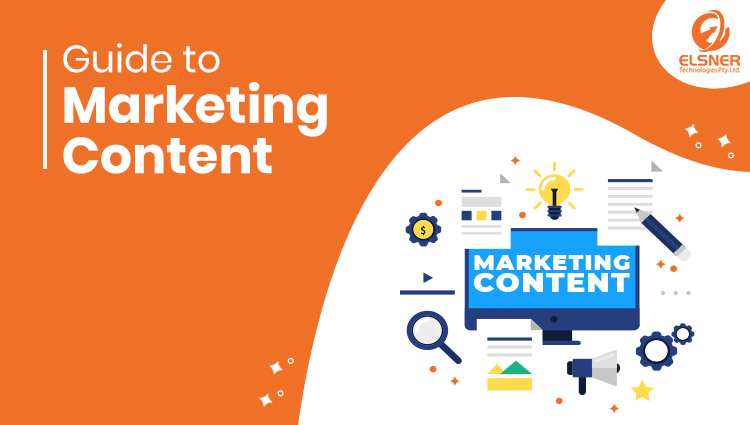A Complete Guide to Marketing the Content
SEOContent these days is one of the best ways of raising brand awareness among a target audience. You can also get online authority, web traffic, leads, and sales from content marketing campaigns.
There is only one question in there.
You won’t get those advantages without the right content marketing plan, strategies, and tools.
What is Marketing Content?
Content Marketing offers a tremendous opportunity for businesses to boost their results. By delivering valuable and relevant content to users, you can improve your online reputation, build a community, and grow advocates of your brand.
However, Content Marketing is not just creating and distributing content. It’s a whole strategic approach that allows you to attract and engage a clearly defined audience and generate profitable customer action ultimately.
Below are some of the tactics listed by some of the SEO services in Sydney Australia that will help you to develop a great Content Marketing strategy for your business.
The Four Elements of a Content Marketing Strategy
An effective Content Marketing strategy must have four core elements to be successful: brand positioning, owned media value proposition, business case, and strategic plan. Let’s see why these elements are essential for Content Marketing and how you can start implementing each of them.
1. Positioning the label
An established brand and product positioning will help you provide a consistent experience for your customers and create the appropriate brand identity across all of your content marketing channels.
The following questions will help you start brainstorming about your position in the market:
- Who are my existing and potential customers?
- What kind of experience do they need?
- What is the competitive landscape?
- How do you market your brands to my top competitors?
- What is my brand’s unique value?
- What problems does my product help to solve?
- What makes it a better choice over my competitors?
- How can I highlight my brand’s personality?
2. Proposition for Media Value
You need to define your media value proposition to establish your brand as a credible content publisher. What unique value do you provide to your audience with your content? Who does separate you from other creators of content? Why should readers choose to follow your content channels?
Start researching your audience to identify the type of information they are looking for and their favorite resources. Then, analyze your competitors’ content strategies to find your editorial niche.
Too often, brands are focusing on their market rivals and don’t pay enough attention to other content creators. Once you decide to develop owned media, you should consider all publishers in your area of expertise as potential competitors. So, make sure that unbranded media, like online magazines, industry blogs, or influencers’ video channels, are a part of your competitive research.
3. Business Case
Providing value to your audience is an integral part of a successful content strategy. But in addition to attracting new readers and followers, Content Marketing should drive your business forward.
Identify the business goals that your company needs to achieve and figure out how Content Marketing will bring your business closer to those goals. How many resources do you need to invest in your content strategy and what results do you want to get from this?
A documented business case will help you better understand the benefits, costs, and risks of implementing a Content Marketing strategy in your company and convince decision-makers of its value for the company.
4. Strategic Plan
A strategic plan should focus on your goals and how exactly you will achieve them. It will help you to think through each step of your content strategy. This plan should help you decide who you want to reach with your Content Marketing efforts, how you will deliver that content to them, and, finally, how you will achieve and measure your targeted results.
Now let’s see how you can develop a perfect content strategy plan with some useful tips and tools that will help you to be more efficient.
What’s a strong marketing strategy for content?
Your marketing strategy for content should be a part of any content creation that your company does. While there are no defined “rules” for creating a marketing strategy for content, it is important to include those key components:
1. Comprehend your audience
Every piece of content that develops within your brand should be created with someone in mind. Consumers are more likely to purchase with a brand they can identify with, and this starts and ends with that brand showing their audience understanding.
Understanding the audience requires very basic considerations such as their age, gender, education level, and even income, but it also goes deeper than that. What would your audience like to see? What are their problems? How do you solve those problems with your product or service?
Don’t just assume. Investigate your target market, and see who is already associated with your brand. You can also set up easy online surveys to send to your current audience, and create output-based audience profiles. Your market may not fit into a single category, but research will help you build a primary “buyer image” that suits several of your audience’s profiles, as well as many secondary people.
2. Keyword research
Place yourself in their shoes, now that you understand your main audience. How do they look for when they need your product or your service? Make a list of your brand ‘s basic keywords, as well as any variations. You know your niche well, but use all the words you can use for what you’ve got to sell. Once you have these keywords, integrate them into your content. There are a few reasons why:
- The incorporation of keywords into blogs and other content is good for SEO and organic traffic generation.
- This helps the audience to easily find out whether or not they have found the material they need before they move on.
- Set up your brand as an authority in your area.
3. Identify effective content
Next, you have to ask yourself what kind of content is my audience going to respond to? What are they in search of? Should you spend time making a video if your audience is more likely to read a blog post? If they want guides, are they going to spend hours looking at case studies that just tell them ‘why’? Likely not.
Defining the most successful content starts by identifying and naming your target, but it will also possibly require some trial and error as you experiment with various content styles to see what works for you and your marketing strategy.
- Articles and blog posts
- Photographs
- Movies
- Whitepapers and ebooks
- A newsletter email
- Posts on social media
- Webinars & E-courses
4. Decide on placement
Another purpose to build an understanding of your audience is to assess where they’re searching for online content. Are they looking for the latest videos in your niche on YouTube or are they spending most of their free time browsing Instagram for great photos?
Implementing an SEO strategy is a good start for content such as blogs, articles, and landing pages which lead to additional content. It’s also important for any relevant social media platforms to maintain active business pages. Another powerful way to extend the scope of your content and create brand awareness can be influencer marketing.
5. Develop your brand’s voice
The most popular brands establish a “personality” that is recognizable and recognized by its audience. In content management, this is often ignored but it is also one of the most critical aspects of a company.
Start with your buyer personas, as with any stage of your marketing strategy for content. What kind of personality do they associate with most? Is that voice formal, polite, or stupid? What kind of language and terms do they want to understand? We don’t want to hear about what?
6. Stay consistent
Keeping consistent is crucial to know if your content strategy is successful. If you post one post per month on Facebook, it will come as no surprise that your Facebook page is not that very soon. Develop and adhere to a Content Schedule.
7. Analyze the results
If it is weekly, monthly, or quarterly, never leave your content without the results being monitored. It could include monitoring display and clicking levels, reading feedback and responses from customers, or even tracking eCommerce stats relevant to your content launches. Tracking data will allow you to evaluate the effects of your marketing activities on content and learn what is successful and what is not.
8. Revisit and revise
Why track the data, if you don’t use the results? It is a good idea to sit down at least once a year, if not once per fiscal quarter, with your content marketing team and go over your current strategy. Note what worked, what didn’t work, and where you want to improve and adjust accordingly.
9. Try new things
Research is great, but if your content marketing timeline allows for a little experimentation it never hurts to try something new. Jump on the trends in social media, try new technology, or reach out to your audience and ask them what they want to see. Just make sure that you always monitor the progress so that as part of your effective marketing plan for the content you can update and eventually add something new.
Now that you’ve developed and been following your marketing strategy for content, it’s time to go through the whole process again! Content marketing strategy is an endless process that needs to be constantly monitored, evaluated, and updated if you want your plan to be successful in collecting leads for your company. Regularly engage, refine, and rework, and your marketing efforts for content will consistently show better results.


















